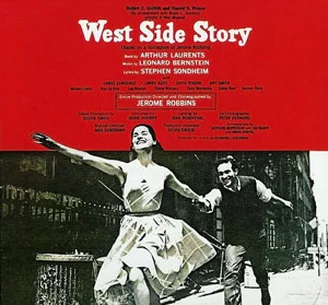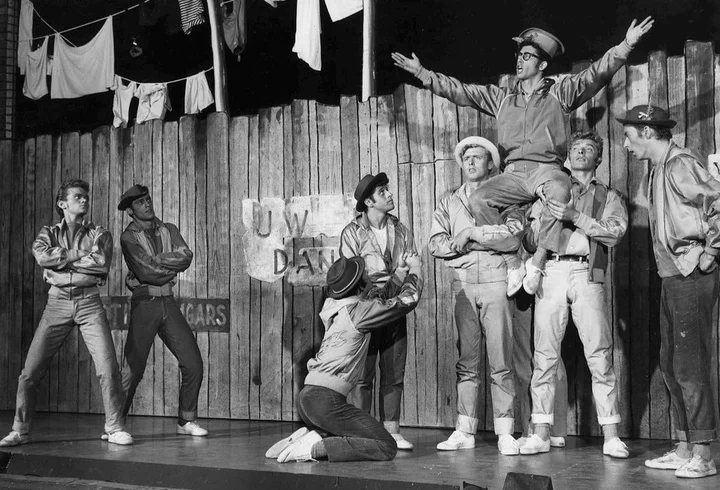We thrilled last week to a rousing medley of numbers from West Side Story played by a professional brass band, bringing back, for me, memories of my first year as an engineering student in London. I’d taken the tube down to the West End, where the musical had been playing for the previous two years to sell-out crowds. For four shillings, I snagged a standing-room-only spot at the back of the stalls where, for nearly three glorious hours, I was transported to Manhattan’s Upper West Side of the mid-1950s.

I think I wore out this LP: Cover of original cast recording, via Wikimedia.
The magic came about via: Leonard Bernstein’s music, blending “jazz, Latin rhythms, symphonic sweep and musical-comedy conventions in groundbreaking ways for Broadway,” according to Misha Berson in the Seattle Times; Jerome Robbin’s fast-paced choreography (with probably the most dancing ever seen at the time in a musical); and Stephen Sondheim’s brilliant lyrics—astonishingly sophisticated from someone in his mid-20s. It didn’t hurt that he’d been mentored by Oscar Hammerstein II.
The basic plot was hardly original, based on Shakespeare’s tragic love story Romeo and Juliet, which itself goes back—through several iterations—at least 2000 years, to Ovid’s Pyramus and Thisbe, the story of two young Babylonian lovers whose parents, motivated by family rivalry, forbid them to wed. Thisbe arrives for their tryst, but flees on seeing a lioness. She loses her cloak as she leaves, so when Pyramus arrives a little later, he finds it, now torn and bloodied by the lioness. Thinking Thisbe’s dead, he falls on his sword—only to be found by Thisbe, who stabs herself. Sound familiar? Shakespeare ran with a later version of this: Romeo and Juliet came from warring families, the Montagues and the Capulets, and you know the rest.
In 1949, West Side Story was originally conceived by dancer, choreographer and director Jerome Robbins, but as East Side Story, with Romeo a member of an Irish Catholic gang, the Jets; and Juliet a Jewish girl who survived the Holocaust. Years later, after several false starts and changes of personnel, the Bernstein-Robbins-Sondheim team, working from a book by Arthur Laurents, created their groundbreaking Latin-themed musical/dance spectacular/Shakespearean tragedy. Instead of Montagues and the Capulets, it has a Puerto Rican gang, the Sharks, battling the home-turf Irish-Polish gang, the Jets. West Side Story opened to rave reviews on Broadway in 1957. The London version which I saw opened the following year with (heart be still) the late Chita Rivera as Anita.
Original 1957 Broadway cast in “Gee, Officer Krupke.” The ending of the original lyrics, “Gee, Officer Krupke, Fuck you!” was changed to “…Krup you!” to avoid censorship. Public domain. Via Wikimedia.
Have you seen the movie? That is, the movies? The 1961 version was the highest-grossing film of that year, winning ten Oscars. Sixty years later, Steven Spielberg made a second adaptation of the original stage show. The divine Puerto Rican dancer and actress Rita Moreno, who played Anita in the 1961 movie (“Best Supporting Actress”), returned as Doc’s widow to sing (I’m moistening up) Somewhere There’s a Place for Us.
I can’t recommend West Side Story enough, in any of its many, many incarnations. There’s been nothing quite like it, before or since.

CLICK TO MANAGE